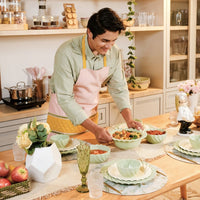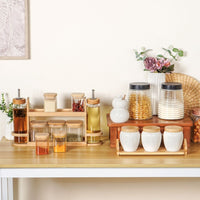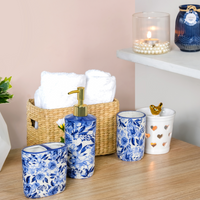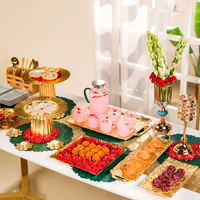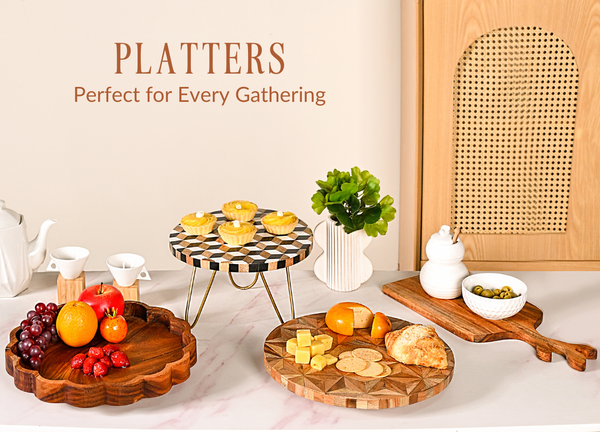Terracotta crockery has been a kitchen staple for centuries, a classic blend of rustic beauty and functional brilliance. Thanks to its natural clay build, terracotta infuses food with an earthy depth that other materials simply can't replicate.
In fact, 70% of chefs say that earthenware cookware significantly enhances the flavour of their dishes.
In this guide, we’re sharing not just why terracotta is magical, but also the top recipes that come alive when cooked in these timeless pots and pans.

Classic Recipes Perfect for Terracotta Crockery
Slow-Cooked Stews and Soups
Bone Broth Recipes
Terracotta is perfect for slow-simmered bone broths. Add beef or chicken bones, a mix of root vegetables like carrots and onions, aromatic herbs like thyme, and plenty of water into a deep terracotta pot.
Cook over low heat for 12–24 hours. The slow, steady warmth helps extract all the goodness, resulting in a rich, gelatinous broth that’s deeply nourishing.
Hearty Vegetable Stew
Dice potatoes, carrots, beans, and seasonal greens. Sauté onions and garlic directly in the terracotta, add the veggies, vegetable broth, tomatoes, and spices, and let everything simmer gently.
Thanks to the crock’s porous structure, the stew stays incredibly moist, and the vegetables absorb every bit of the herby, spiced broth.
Tip: Use low heat to avoid cracking and to allow flavours to build slowly.
Baked Bread and Flatbreads
Traditional Sourdough Loaves
Prepare your sourdough starter and dough as usual. Once ready, place the dough into a pre-soaked terracotta pot or cloche. The moisture from the pot creates steam, giving the bread an incredible rise and that iconic crackling crust with a tender inside. The even heat distribution ensures your loaf bakes thoroughly without burnt bottoms.
Rustic Flatbreads
Mix flour, water, salt, olive oil, and a bit of yeast to create a soft dough. Roll out into rustic rounds and cook directly on a heated terracotta griddle or inside a flat casserole dish.
The result? Soft, slightly smoky flatbreads with golden blisters — perfect for scooping up hummus or stews.
Tip: Soak your terracotta before baking — it helps create a naturally steamy baking environment.

Roasts and Casseroles
Juicy Chicken Roast
Marinate a whole chicken in olive oil, lemon juice, garlic, rosemary, and thyme. Layer sliced onions and potatoes at the bottom of a terracotta roasting pot, place the chicken on top, cover with the lid, and slow-roast. The chicken will cook evenly, staying exceptionally juicy while the skin crisps beautifully without drying out.
Vegetable Casseroles with Deep Flavours
Layer vegetables like zucchini, eggplant, mushrooms, and sweet potatoes with marinara sauce and cheese inside a deep terracotta casserole dish. As the casserole bakes, the vegetables caramelize slowly, releasing their natural sugars and blending into a rich, hearty dish with depth and warmth.
Tip: Keep the lid on for the first half of cooking, then remove it to brown the top perfectly.
Innovative Dishes That Shine in Terracotta
Finger Foods and Appetizers
Stuffed Peppers
Hollow out bell peppers and fill them with a mixture of cooked quinoa, black beans, corn, cheese, and spices. Arrange them snugly in a terracotta dish, pour a little stock around them, cover, and bake.
The peppers cook evenly without collapsing, and the filling stays moist and flavourful.
Mini Lasagnas
Use small terracotta ramekins to layer pasta sheets with ricotta, spinach, marinara sauce, and mozzarella.
Baking them individually ensures crisp edges and bubbling cheese on top, and each guest gets their own personal lasagna — fun and practical for dinner parties!
Technique: Lightly preheat your terracotta dish before filling to encourage golden, crispy sides.
Desserts in Earthenware
Baked Fruit Cobblers
Toss seasonal fruits like peaches, berries, or apples with sugar and a sprinkle of cinnamon. Top with biscuit dough or crumble topping and bake in terracotta. The fruits caramelize while the topping turns golden and crisp — and the pot retains heat beautifully for serving straight to the table.
Rice Pudding
Mix rice, milk, sugar, cardamom pods, and a handful of raisins, and bake slowly in terracotta.
The milk slowly thickens without scorching, and the pudding develops a luscious, melt-in-your-mouth texture infused with subtle earthy undertones.
Tip: Use glazed terracotta for stickier desserts — it makes cleanup simple.

Tips for Using and Caring for Terracotta Crockery
-
Proper Soaking
Always soak new terracotta cookware in water for 12–24 hours before first use to strengthen the material. -
Gentle Cleaning
Skip harsh soaps. Use warm water and a gentle scrub brush. Let pieces dry completely before storing. -
Storage Advice
Store pieces separately or with a paper towel between them to avoid moisture buildup and cracking. -
Refurbishing Tip
Old terracotta? Re-soak and season it by baking it slowly at a low temperature to restore vitality.Shop Now
Actionable Takeaways
-
Match traditional, slow-cooked dishes with terracotta for maximum flavour.
-
Follow easy care steps to make your earthenware last for decades.
-
Start experimenting: even modern dishes can adapt wonderfully to terracotta cooking.

Conclusion
Terracotta crockery isn’t just beautiful; it is a flavour powerhouse. At Nestasia, we craft our terracotta collection with love and precision, using natural clay that enhances both your cooking and your table settings. Each piece is designed to bring warmth, authenticity, and rich flavour to your meals from hand-glazed baking dishes to beautifully moulded pots. Discover cookware that not only looks stunning but also transforms the way you cook, one hearty dish at a time. Whether you are baking rustic bread, slow-roasting a chicken, or simmering a soulful stew, terracotta draws out the best in your ingredients. Simple steps like soaking, gentle cleaning, and low-heat cooking can open up a world of flavours you did not even know you were missing. Try it out today and taste the magic yourself!

